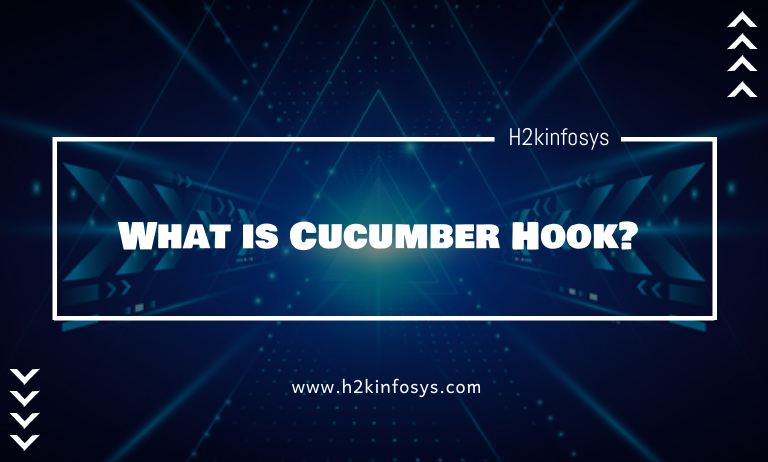What is Cucumber Hook?
Cucumber hook is a block of code which is defined with scenario in the step definition file by using its own annotations @before and @after. Cucumber Hook allows us to handle the code work flow better and helps in reducing the redundancy. Actually the Hook is mainly used to start or close the web driver session after a specific function. Therefore is not relevant to any scenario.
The need for a Hook
Some times when testing, we may face some circumstances where we need to perform some pre-requisite steps before the test scenario.
The pre-requisites which may be faced are:
- To start a web driver and set up database connections.
- Setting up test data and setting up browser cookies
- Navigating to certain page
To handle these pre-requisite steps we have to use some Cucumber Hook. In cucumber there are two types of Hooks:
@Before ,@After
We can use @Before hook with any function or method when we have to start a web driver.
We can use @After hook with any function or method when we have to close web driver.
Consider an example of a tagged Hook:
@Before ('@RegressionTest)
@After ('@RegressionTest) 



























16 Responses
Cucumber hook is a block of code which is defined with scenario in the step definition file by using its own annotations @before and @after. Cucumber Hook allows us to handle the code work flow better and helps in reducing the redundancy.
The Hook is mainly used to start or close the web driver session after a specific function . Therefore is not relevant to any scenario.
Cucumber hook is block of code which is defined with scenario in the step defination file by using its own annotation @before and @after The hook is mainly used to start or close the web driver session after a specific function .therefore is not relevant to any scenario
Cucumber hook is a block of code which is defined with scenario in the step definition file by using its own annotations @before and @after. Cucumber Hook allows us to handle the code work flow better and helps in reducing the redundancy. Actually the Hook is mainly used to start or close the web driver session after a specific function. Therefore is not relevant to any scenario.
Some times when testing, we may face some circumstances where we need to perform some pre-requisite steps before the test scenario.
To handle these pre-requisite steps we have to use some Cucumber Hook. In cucumber there are two types of Hooks:
@Before ,@After
We can use @Before hook with any function or method when we have to start a web driver.
We can use @After hook with any function or method when we have to close web driver.
An example of a tagged Hook:
@Before (‘@RegressionTest)
@After (‘@RegressionTest)
– Cucumber hook is a block of code which is defined with scenario in the step definition file by using its own annotations @before and @after.
– The Hook is mainly used to start or close the web driver session after a specific function. Therefore is not relevant to any scenario.
– Some times when testing, we may face some circumstances where we need to perform some pre-requisite steps before the test scenario.
– To handle these pre-requisite steps we have to use some Cucumber Hook.
– In cucumber there are two types of Hooks:
1.@Before : We can use @Before hook with any function or method when we have to start a web driver.
2. @After: We can use @After hook with any function or method when we have to close web driver.
Cucumber hook is a block of code which is defined with scenario in the step definition file by using its own annotations @before and @after. Cucumber Hook allows us to handle the code work flow better and helps in reducing the redundancy. Actually the Hook is mainly used to start or close the web driver session after a specific function. Therefore is not relevant to any scenario.
The need for a Hook .Some times when testing, we may face some circumstances where we need to perform some pre-requisite steps before the test scenario.
The pre-requisites which may be faced are:
To start a web driver and set up database connections.
Setting up test data and setting up browser cookies
Navigating to certain page
Cucumber hook is a block of code which is defined with scenario in the step definition file by using its own annotations @before and @after. Cucumber Hook allows us to handle the code work flow better and helps in reducing the redundancy. Actually the Hook is mainly used to start or close the web driver session after a specific function. Therefore is not relevant to any scenario.
Cucumber hook is a block of code which is defined with scenario in the step definition file by using its own annotations @before and @after. Cucumber Hook allows us to handle the code work flow better and helps in reducing the redundancy. Actually the Hook
The need for a Hook
Some times when testing, we may face some circumstances where we need to perform some pre-requisite steps before the test scenario. mainly used to start or close the web driver session after a specific function. Therefore is not relevant to any scenario
Cucumber hook is a block of code which is defined with scenario in the step definition file by using its own annotations @before and @after. Cucumber Hook allows us to handle the code work flow better and helps in reducing the redundancy.
The need for a Hook:
Some times when testing, we may face some circumstances where we need to perform some pre-requisite steps before the test scenario.
1. To start a web driver and set up database connections.
2. Setting up test data and setting up browser cookies
3.Navigating to certain page
To handle these pre-requisite steps we have to use some Cucumber Hook. In cucumber there are two types of Hooks:
@Before ,@After
1. We can use @Before hook with any function or method when we have to start a web driver.
2. We can use @After hook with any function or method when we have to close web driver.
Cucumber hook is a block of code which is defined with scenario in the step definition file by using its own annotations @before and @after.
Cucumber hook is a block of code which is defined with scenario in the step definition file by using its own annotations @before and @after. Cucumber Hook allows us to handle the code work flow better and helps in reducing the redundancy. Actually the Hook is mainly used to start or close the web driver session after a specific function. Therefore is not relevant to any scenario.
The need for a Hook
Some times when testing, we may face some circumstances where we need to perform some pre-requisite steps before the test scenario.
The pre-requisites which may be faced are:
1. To start a web driver and set up database connections.
2. Setting up test data and setting up browser cookies
3. Navigating to certain page
To handle these pre-requisite steps we have to use some Cucumber Hook. In cucumber there are two types of Hooks:
@Before ,@After
We can use @Before hook with any function or method when we have to start a web driver.
We can use @After hook with any function or method when we have to close web driver.
Cucumber hook is a block of code which is defined with scenario in the step definition file by using its own annotations @before and @after. Cucumber Hook allows us to handle the code work flow better and helps in reducing the redundancy. Actually the Hook is mainly used to start or close the web driver session after a specific function. Therefore is not relevant to any scenario. The pre-requisites which may be faced are:
To start a web driver and set up database connections.
Setting up test data and setting up browser cookies
Navigating to certain page
To handle these pre-requisite steps we have to use some Cucumber Hook. In cucumber there are two types of Hooks:
@Before ,@After
We can use @Before hook with any function or method when we have to start a web driver.
We can use @After hook with any function or method when we have to close web driver.
A cucumber hook is a block of code that is defined with a scenario in the step definition file by using its own annotations @before and @after. Cucumber Hook allows us to handle the code workflow better and helps in reducing redundancy. Actually, the Hook is mainly used to start or close the web driver session after a specific function. Therefore is not relevant to any scenario.
The need for a Hook
Sometimes when testing, we may face some circumstances where we need to perform some pre-requisite steps before the test scenario.
The pre-requisites which may be faced are:
*To start a web driver and set up database connections.
*Setting up test data and setting up browser cookies
*Navigating to a certain page
*To handle these pre-requisite steps we have to use some Cucumber Hook.
In cucumber there are two types of Hooks:
@Before,@After
We can use the @Before hook with any function or method when we have to start a web driver.
We can use the @After hook with any function or method when we have to close the web driver.
Cucumber hook is a block of code which is defined with scenario in the step definition file by using its own annotations @before and @after. Cucumber Hook allows us to handle the code work flow better and helps in reducing the redundancy. Actually, the Hook is mainly used to start or close the web driver session after a specific function. Therefore, is not relevant to any scenario.
The need for a Hook
Some times when testing, we may face some circumstances where we need to perform some pre-requisite steps before the test scenario.
The pre-requisites which may be faced are:
1. To start a web driver and set up database connections.
2. Setting up test data and setting up browser cookies
3. Navigating to certain page
To handle these pre-requisite steps we have to use some Cucumber Hook. In cucumber there are two types of Hooks:
@Before ,@After
We can use @Before hook with any function or method when we have to start a web driver.
We can use @After hook with any function or method when we have to close web driver.
Consider an example of a tagged Hook:
@Before(‘@RegressonTest)
@After(‘@RegressonTest)
Cucumber hook is a block of code which is defined with scenario in the step definition file by using its own annotations @before and @after. Cucumber Hook allows us to handle the code work flow better and helps in reducing the redundancy. Actually the Hook is mainly used to start or close the web driver session after a specific function. Therefore is not relevant to any scenario.
Some times when testing, we may face some circumstances where we need to perform some pre-requisite steps before the test scenario.
To handle these pre-requisite steps we have to use some Cucumber Hook. In cucumber there are two types of Hooks: @Before ,@After
We can use @Before hook with any function or method when we have to start a web driver.
We can use @After hook with any function or method when we have to close web driver.
An example of a tagged Hook:
@Before (‘@RegressionTest)
@After (‘@RegressionTest)
Cucumber hook is a block of code which is defined with scenario in the step definition file by using its own annotations @before and @after. Cucumber Hook allows us to handle the code work flow better and helps in reducing the redundancy. Actually the Hook is mainly used to start or close the web driver session after a specific function. Therefore is not relevant to any scenario.
Some times when testing, we may face some circumstances where we need to perform some pre-requisite steps before the test scenario.
The pre-requisites which may be faced are:
* To start a web driver and set up database connections.
* Setting up test data and setting up browser cookies
* Navigating to certain page
To handle these pre-requisite steps we have to use some Cucumber Hook. In cucumber there are two types of Hooks:
@Before ,@After
We can use @Before hook with any function or method when we have to start a web driver.
We can use @After hook with any function or method when we have to close web driver.
Cucumber hook is a block of code which is defined with scenario in the step definition file by using its own annotations @before and @after. Cucumber Hook allows us to handle the code work flow better and helps in reducing the redundancy. Actually the Hook is mainly used to start or close the web driver session after a specific function. Therefore is not relevant to any scenario.
The pre-requisites which may be faced are:
1.To start a web driver and set up database connections.
2.Setting up test data and setting up browser cookies
3.Navigating to certain page
We can use @Before hook with any function or method when we have to start a web driver.
We can use @After hook with any function or method when we have to close web driver.